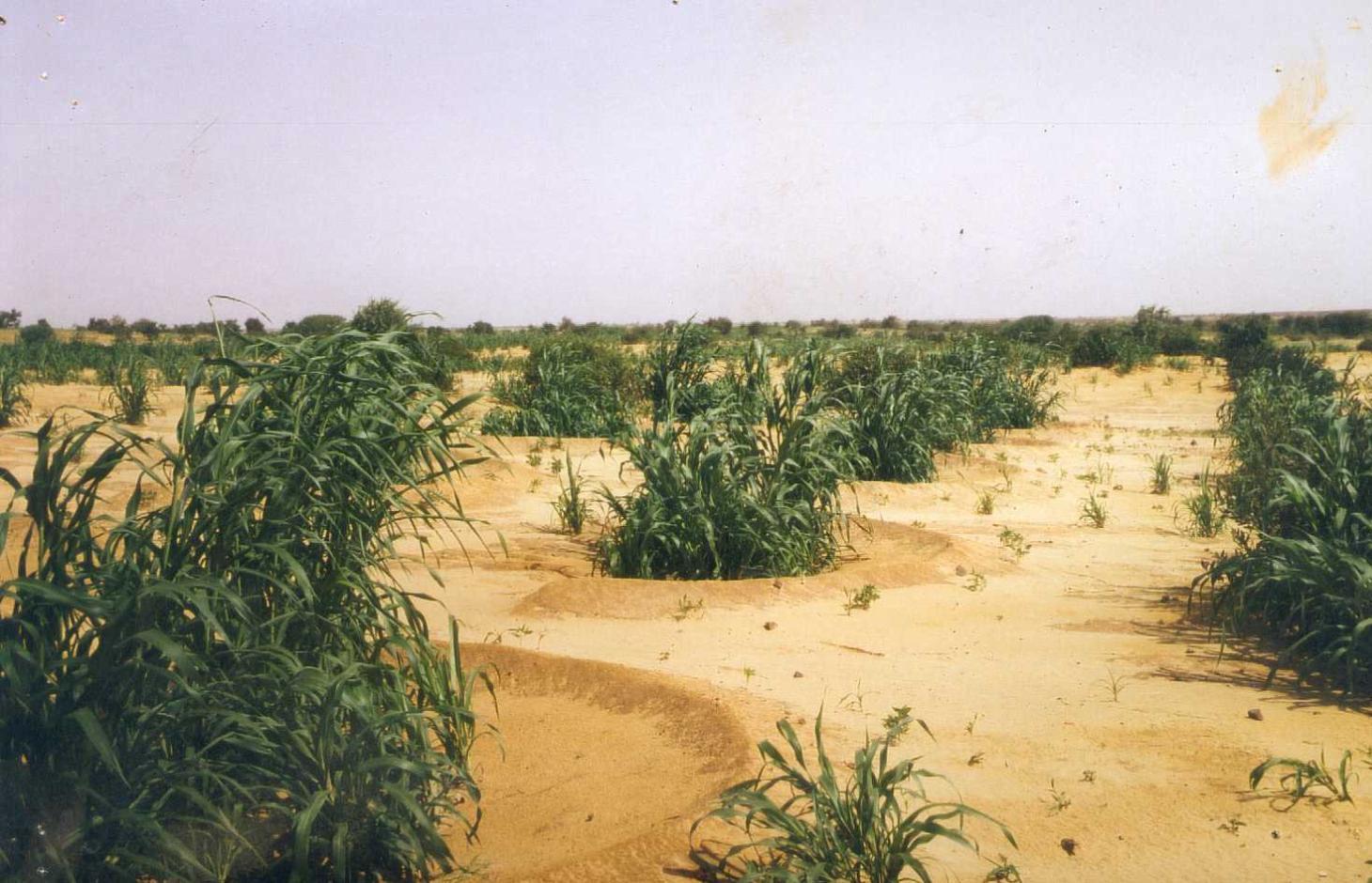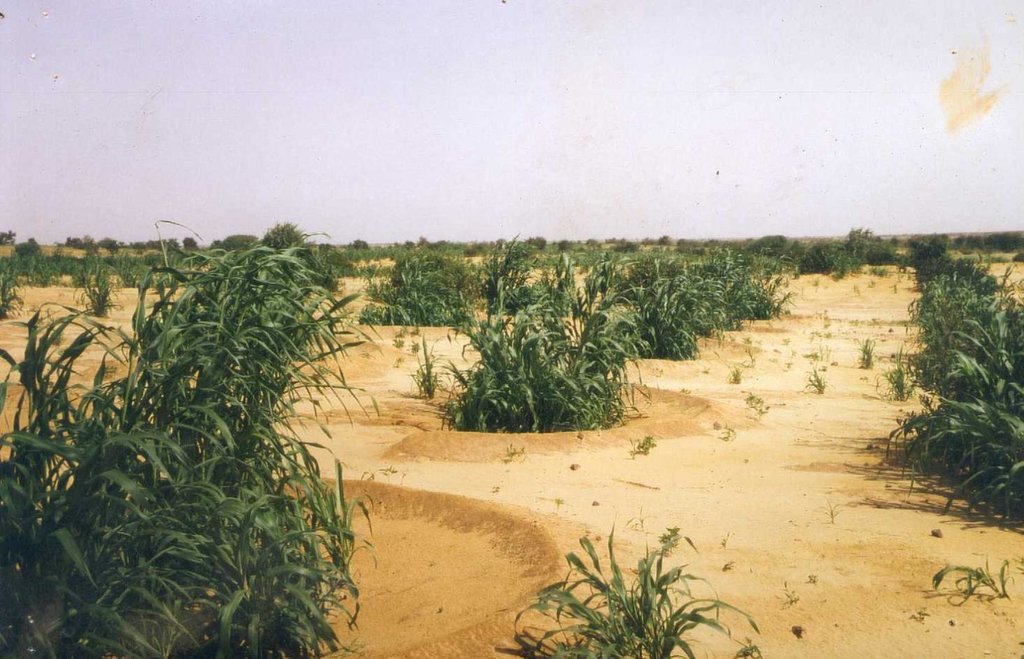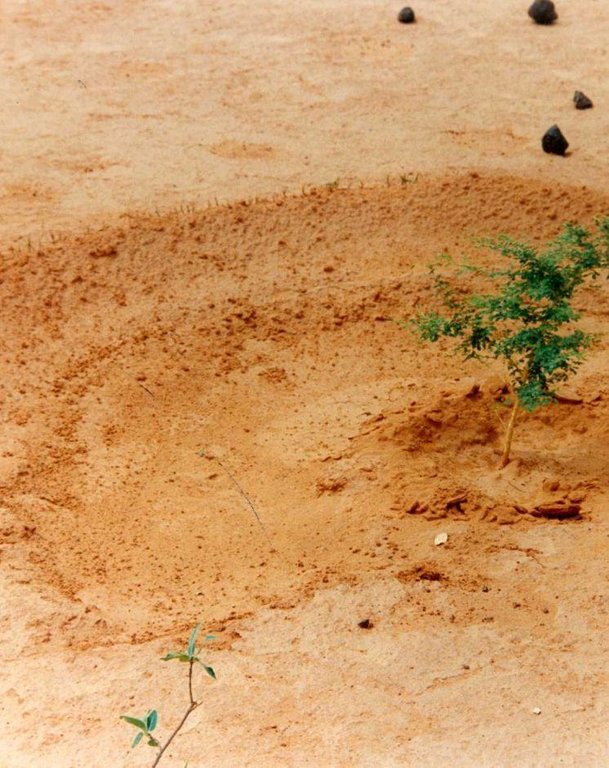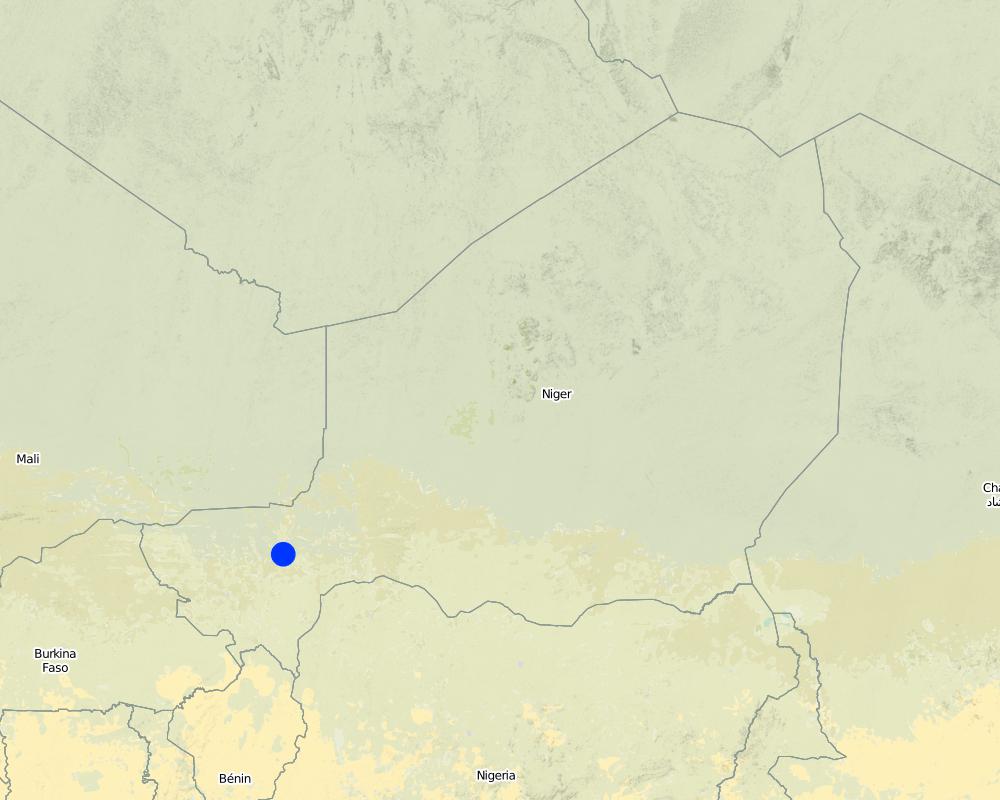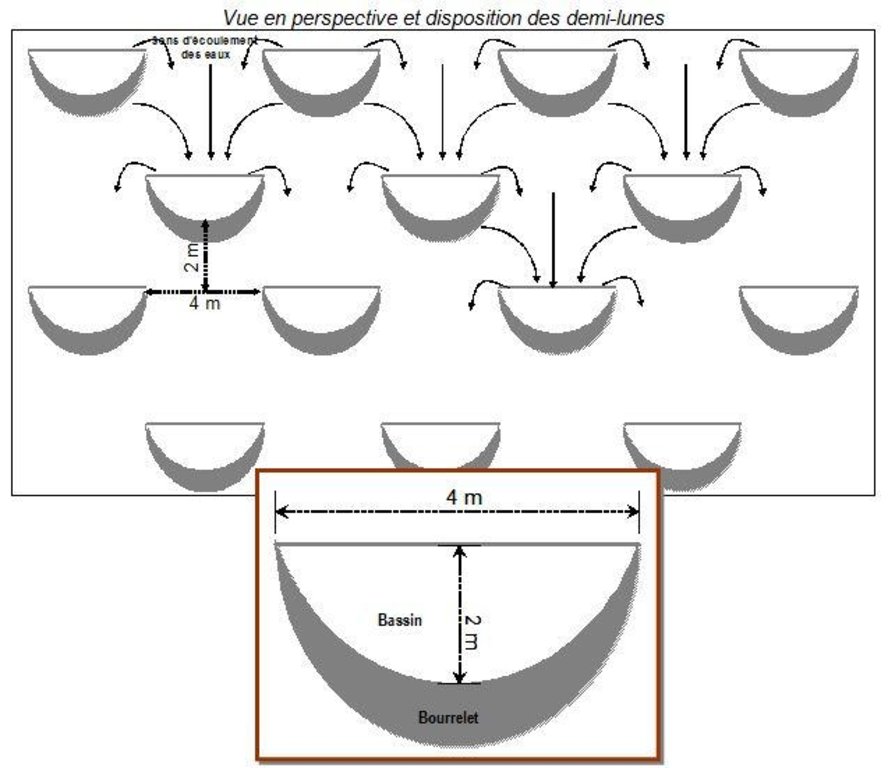Semi-circular bunds (for crops and forest/rangeland) [Niger]
- Creation:
- Update:
- Compiler: Dieter Nill
- Editor: –
- Reviewers: Deborah Niggli, Alexandra Gavilano
Demi-lunes (French)
technologies_1614 - Niger
View sections
Expand all Collapse all1. General information
1.2 Contact details of resource persons and institutions involved in the assessment and documentation of the Technology
SLM specialist:
Sani Mamadou Abdou
Programme d’Appui à l’agriculture Productive (PROMAP), Niamey, Niger
Niger
Name of project which facilitated the documentation/ evaluation of the Technology (if relevant)
Good Practices in Soil and Water Conservation - A contribution to adaptation and farmers ́ resilience towards climate change in the Sahel (GIZ)Name of the institution(s) which facilitated the documentation/ evaluation of the Technology (if relevant)
Deutsche Gesellschaft für Internationale Zusammenarbeit (GIZ) GmbH (GIZ) - Germany1.3 Conditions regarding the use of data documented through WOCAT
The compiler and key resource person(s) accept the conditions regarding the use of data documented through WOCAT:
Yes
1.4 Declaration on sustainability of the described Technology
Is the Technology described here problematic with regard to land degradation, so that it cannot be declared a sustainable land management technology?
No
2. Description of the SLM Technology
2.1 Short description of the Technology
Definition of the Technology:
Semi-circular bunds are used to rehabilitate degraded, denuded and hardened land for crop growing, grazing or forestry.
2.2 Detailed description of the Technology
Description:
This technique involves building low embankments with compacted earth or stones in the form of a semi-circle with the opening perpendicular to the flow of water and arranged in staggered rows. They are constructed on gently to moderately sloping pediments and plateau areas in order to rehabilitate areas that are degraded, denuded and/or affected by soil crusting.
Depending on their purpose, the areas inside the semi-circular bunds, enriched with organic fertiliser, are used for growing cereals (crop crescents) and for planting trees, bushes and/or grasses (forestry and pastoral crescents). Semi-circular bunds slow down and capture runoff, providing the plants inside them with the water they need. They therefore reduce the loss of water and the fertile layers of the soil. This is particularly advantageous when rain is scarce, as the semi-circular bunds channel water towards the plants, increasing the moisture available to them. In the medium term, rich sediment builds up behind the semi-circular bunds, which helps to protect and restore the land. The bunds ensure that the manure placed around the plants inside them is not washed away by heavy rains, and the ridge of the bund protects young plants from the wind and wind erosion. When they are used for reforestation, they increase the rate of survival of the trees planted in them. Cropland bunds enable crops to survive dry spells. Earthen bunds are not, however, suitable in a scenario with heavy rainfall. They do not allow water to filter through, which can result in the soil inside them becoming waterlogged and the plants being flooded. This can lower yields in the case of crops that do not tolerate excess water. In such conditions, stone bunds are preferable.
To establish semi-circular bunds on cropland, the following activities are required: marking out the contour line, laying out the lines of the semi-circular bunds in staggered rows, digging the microcatchment, forming the ridge downhill of the microcatchment, applying organic fertiliser (around 1 t per ha per year).
To establish semi-circular bunds on forestland the same steps are required, however instead of applying fertilizer, other steps include digging the holes, planting the trees, and sowing grass on the ridges. The earthen ridges around cropland bunds need to be rebuilt each year. It is recommended that the ridges of forest/rangeland bunds be maintained each year and raised if overflowing has occurred. Forest/rangeland sites should be protected from grazing animals in the first two to three years, until the vegetation is well established. This requires good community organisation. After dry years, forest/rangeland semi-circular bunds may have to be re-sown with grasses and replanted with trees.
The Sahel is a region where the population has always faced a high degree of climate variability, manifested both in terms of time (unexpected dry spells can occur during the rainy season) and in terms of space (rainfall can vary greatly from one area to another). The population is mainly composed of small farmers and livestock keepers.
Over the last two decades, the effects of climate change have exacerbated the already difficult conditions. Accord¬ing to projections made by climatologists, the Sahel will experience a rise in temperatures combined with highly variable rainfall and an increase in extreme weather events. The Soil and Water conservation and rehabilitation techniques have helped people in the Sahel to manage their ecosystems more effectively and improve their productive land. As a result, communities are better prepared to cope with environmental changes (changes in the climate, land degradation, etc.) and the im¬pact of shocks, particularly droughts.
2.3 Photos of the Technology
2.5 Country/ region/ locations where the Technology has been applied and which are covered by this assessment
Country:
Niger
Region/ State/ Province:
Niger, Burkina Faso, Chad
Further specification of location:
Regions of Tillabéri, Filingué, Ouallam, Téra and Tahuoa in Niger; Bam region in Burkina Faso
Specify the spread of the Technology:
- evenly spread over an area
If precise area is not known, indicate approximate area covered:
- 10-100 km2
Comments:
Also implemented in Burkina Faso and Chad
Regions of Tillabéri, Filingué, Ouallam, Téra and Tahuoa in Niger; Bam region in Burkina Faso
Map
×2.6 Date of implementation
If precise year is not known, indicate approximate date:
- 10-50 years ago
2.7 Introduction of the Technology
Specify how the Technology was introduced:
- through projects/ external interventions
Comments (type of project, etc.):
developed, implemented and disseminated as part of projects and programmes undertaken from the 1980s onwards to combat desertification and improve natural resource management. Implemented by GIZ (German Federal Enterprise for International Cooperation), PDRT (Projet de développement rural de Tahoua - Tahoua Rural Development Project), PASP (Projet de protection intégrée des ressources agro-sylvo-pastorales Tillabéri-Nord - Project for the Integrated Protection of Agricultural, Forest and Rangeland Resources in Tillabéri-Nord)
3. Classification of the SLM Technology
3.1 Main purpose(s) of the Technology
- reduce, prevent, restore land degradation
3.2 Current land use type(s) where the Technology is applied

Cropland
- Annual cropping
Number of growing seasons per year:
- 1
Specify:
Longest growing period in days: 120, Longest growing period from month to month: August to October

Forest/ woodlands
- (Semi-)natural forests/ woodlands
(Semi-)natural forests/ woodlands: Specify management type:
- Selective felling
Products and services:
- Timber
- Fuelwood
- Fruits and nuts
- Other forest products
- Grazing/ browsing
Comments:
Major land use problems (compiler’s opinion): droughts, soil erosion, lack of water, surface runoff, soil crusting, unadapted land use methods, rapidly growing population increasing pressure on land, reduced or abandoned fallow periods, soil erosion, insecure access to land.
Cut-and-carry/ zero grazing, Improved pasture, agropastolralism
Livestock density: 1-10 LU /km2
3.4 Water supply
Water supply for the land on which the Technology is applied:
- mixed rainfed-irrigated
3.5 SLM group to which the Technology belongs
- agroforestry
- pastoralism and grazing land management
3.6 SLM measures comprising the Technology

structural measures
- S2: Bunds, banks
3.7 Main types of land degradation addressed by the Technology

soil erosion by water
- Wt: loss of topsoil/ surface erosion

chemical soil deterioration
- Cn: fertility decline and reduced organic matter content (not caused by erosion)

physical soil deterioration
- Pk: slaking and crusting

water degradation
- Ha: aridification
Comments:
Main causes of degradation: soil management (Unadapted landuse methods, reduced or abandoned fallow periods), crop management (annual, perennial, tree/shrub) (Neglect of fallow periods and crop rotation), droughts (due to heat waves), population pressure (rapidly growing population, increasing pressure on land), land tenure (insecure access to land and collectively managed community land), poverty / wealth (very poor population)
Secondary causes of degradation: deforestation / removal of natural vegetation (incl. forest fires) (deforestation through overgrazing and fire wood collection), over-exploitation of vegetation for domestic use (firewood collection), overgrazing (cattle, sheep and goats), change in temperature (Climate change: heat waves), change of seasonal rainfall (more variable onset of rain), Heavy / extreme rainfall (intensity/amounts) (more variable and intensive rains), wind storms / dust storms (frequent storms), floods (due to intensive rain storms), labour availability (some migration of men to nearby cities), education, access to knowledge and support services (high level of illiteracy)
3.8 Prevention, reduction, or restoration of land degradation
Specify the goal of the Technology with regard to land degradation:
- reduce land degradation
- restore/ rehabilitate severely degraded land
4. Technical specifications, implementation activities, inputs, and costs
4.1 Technical drawing of the Technology
Technical specifications (related to technical drawing):
Source: Ministère du Développement Agricole Niger (without date): Recueil des fiches techniques en gestion des ressources naturelles et de productions agro-sylvo-pastorales.
Technical knowledge required for field staff / advisors: moderate
Technical knowledge required for land users: low
Main technical functions: control of dispersed runoff: retain / trap, control of dispersed runoff: impede / retard, control of concentrated runoff: retain / trap, control of concentrated runoff: impede / retard, increase of infiltration, increase / maintain water stored in soil, water harvesting / increase water supply, sediment retention / trapping, sediment harvesting
Secondary technical functions: improvement of surface structure (crusting, sealing), stabilisation of soil (eg by tree roots against land slides), increase in nutrient availability (supply, recycling,…), reduction in wind speed
Bund/ bank: semi-circular/V shaped trapezoidal
Depth of ditches/pits/dams (m): 0,15-0,20
Width of ditches/pits/dams (m): 2
Length of ditches/pits/dams (m): 4
4.2 General information regarding the calculation of inputs and costs
other/ national currency (specify):
CFA Franc
If relevant, indicate exchange rate from USD to local currency (e.g. 1 USD = 79.9 Brazilian Real): 1 USD =:
521.18
4.3 Establishment activities
| Activity | Timing (season) | |
|---|---|---|
| 1. | marking out the contour line | |
| 2. | laying out the lines of the semi-circular bunds in stag- gered rows | |
| 3. | digging the microcatchment | |
| 4. | forming the ridge downhill of the microcatchment | |
| 5. | applying organic fertiliser (around 1 t per ha per year) (only on cropland, this step is not required on forestland) | |
| 6. | digging the holes (only on forestland) | |
| 7. | planting the trees (only on forestland) | |
| 8. | sowing grass on the ridges (only on forestland) |
4.4 Costs and inputs needed for establishment
| Specify input | Unit | Quantity | Costs per Unit | Total costs per input | % of costs borne by land users | |
|---|---|---|---|---|---|---|
| Labour | labour | ha | 1.0 | 201.5 | 201.5 | 100.0 |
| Equipment | tools | ha | 1.0 | 17.3 | 17.3 | 100.0 |
| Total costs for establishment of the Technology | 218.8 | |||||
| Total costs for establishment of the Technology in USD | 0.42 | |||||
4.5 Maintenance/ recurrent activities
| Activity | Timing/ frequency | |
|---|---|---|
| 1. | The earthen ridges around cropland bunds need to be rebuilt each year | each year |
| 2. | the ridges of forest/rangeland bunds be maintained each year and raised if overflowing has occurred. | each year |
| 3. | After dry years, forest/rangeland semi-circular bunds may have to be re-sown with grasses and replanted with trees. | after dry years |
| 4. | Forest/rangeland sites should be protected from grazing animals in the first two to three years, until the vegetation is well established. | in the first two to three years |
4.6 Costs and inputs needed for maintenance/ recurrent activities (per year)
Comments:
other costs for cropland semi-circular bunds: 10 cartloads of manure.
other costs for forestland semi-circular bunds:
• 625 tree seedlings
• 15 kg of grass seed
• cost of transporting 625 tree seedlings (2 cartloads)
• 120 seedlings to replace trees that die.
4.7 Most important factors affecting the costs
Describe the most determinate factors affecting the costs:
In the case of forest/rangeland semi-circular bunds, the availability of tree and grass seeds and seedlings is a vital factor. In the PDRT and PASP projects in Niger, the villages had nurseries, and members of the village land manage- ment committees collected grass seeds from rangelands to sow in the semi-circular bunds.
5. Natural and human environment
5.1 Climate
Annual rainfall
- < 250 mm
- 251-500 mm
- 501-750 mm
- 751-1,000 mm
- 1,001-1,500 mm
- 1,501-2,000 mm
- 2,001-3,000 mm
- 3,001-4,000 mm
- > 4,000 mm
Agro-climatic zone
- semi-arid
Thermal climate class: subtropics
5.2 Topography
Slopes on average:
- flat (0-2%)
- gentle (3-5%)
- moderate (6-10%)
- rolling (11-15%)
- hilly (16-30%)
- steep (31-60%)
- very steep (>60%)
Landforms:
- plateau/plains
- ridges
- mountain slopes
- hill slopes
- footslopes
- valley floors
Altitudinal zone:
- 0-100 m a.s.l.
- 101-500 m a.s.l.
- 501-1,000 m a.s.l.
- 1,001-1,500 m a.s.l.
- 1,501-2,000 m a.s.l.
- 2,001-2,500 m a.s.l.
- 2,501-3,000 m a.s.l.
- 3,001-4,000 m a.s.l.
- > 4,000 m a.s.l.
5.3 Soils
Soil depth on average:
- very shallow (0-20 cm)
- shallow (21-50 cm)
- moderately deep (51-80 cm)
- deep (81-120 cm)
- very deep (> 120 cm)
Soil texture (topsoil):
- medium (loamy, silty)
- fine/ heavy (clay)
Topsoil organic matter:
- medium (1-3%)
5.4 Water availability and quality
Ground water table:
5-50 m
Availability of surface water:
medium
Water quality (untreated):
for agricultural use only (irrigation)
5.5 Biodiversity
Species diversity:
- low
5.6 Characteristics of land users applying the Technology
Market orientation of production system:
- subsistence (self-supply)
- mixed (subsistence/ commercial)
Off-farm income:
- 10-50% of all income
Relative level of wealth:
- very poor
- poor
Level of mechanization:
- manual work
- animal traction
Gender:
- men
Indicate other relevant characteristics of the land users:
Population density: 10-50 persons/km2
Annual population growth: 3% - 4% (mostly poor households below poverty line).
Off-farm income specification: men migrate temporarily or permanently to cities for off-farm income, women and men seaonally carry out paid farm labour
5.7 Average area of land used by land users applying the Technology
- < 0.5 ha
- 0.5-1 ha
- 1-2 ha
- 2-5 ha
- 5-15 ha
- 15-50 ha
- 50-100 ha
- 100-500 ha
- 500-1,000 ha
- 1,000-10,000 ha
- > 10,000 ha
Is this considered small-, medium- or large-scale (referring to local context)?
- small-scale
5.8 Land ownership, land use rights, and water use rights
Land ownership:
- state
- communal/ village
Land use rights:
- open access (unorganized)
- communal (organized)
Water use rights:
- open access (unorganized)
- communal (organized)
Comments:
traditional land use rights are prevailing. On fields individual land use rights, communal rights on pasture and forest land (collection of wood and other products (fruits, medicinal plants))
5.9 Access to services and infrastructure
health:
- poor
- moderate
- good
education:
- poor
- moderate
- good
technical assistance:
- poor
- moderate
- good
employment (e.g. off-farm):
- poor
- moderate
- good
markets:
- poor
- moderate
- good
energy:
- poor
- moderate
- good
roads and transport:
- poor
- moderate
- good
drinking water and sanitation:
- poor
- moderate
- good
financial services:
- poor
- moderate
- good
6. Impacts and concluding statements
6.1 On-site impacts the Technology has shown
Socio-economic impacts
Production
crop production
Comments/ specify:
Cropland bunds constructed on abandoned farmland increase millet yields by 180 kg and straw yields by 400 kg per hectare per year
fodder production
animal production
Comments/ specify:
Forest/rangeland sites should be protected from grazing animals in the first two to three years, until the vegetation is well established. This requires good community organisation.
wood production
Comments/ specify:
Sites improved with semi-circular bunds for reforestation produce one stere of wood per hectare per year after ten years. The value of this production can increase further from the fifth year onwards to around 850,000 CFA francs per hectare
Water availability and quality
demand for irrigation water
Income and costs
workload
Socio-cultural impacts
food security/ self-sufficiency
conflict mitigation
contribution to human well-being
Comments/ specify:
notably increses production of food, fodder and forest products
Ecological impacts
Water cycle/ runoff
harvesting/ collection of water
surface runoff
Soil
soil moisture
soil loss
soil crusting/ sealing
nutrient cycling/ recharge
Biodiversity: vegetation, animals
plant diversity
animal diversity
Climate and disaster risk reduction
wind velocity
Other ecological impacts
survival of planted trees
6.2 Off-site impacts the Technology has shown
water availability
downstream flooding
downstream siltation
buffering/ filtering capacity
damage on neighbours' fields
damage on public/ private infrastructure
6.3 Exposure and sensitivity of the Technology to gradual climate change and climate-related extremes/ disasters (as perceived by land users)
Gradual climate change
Gradual climate change
| Season | increase or decrease | How does the Technology cope with it? | |
|---|---|---|---|
| annual temperature | increase | well |
Climate-related extremes (disasters)
Meteorological disasters
| How does the Technology cope with it? | |
|---|---|
| local rainstorm | not well |
| local windstorm | well |
Climatological disasters
| How does the Technology cope with it? | |
|---|---|
| drought | well |
Hydrological disasters
| How does the Technology cope with it? | |
|---|---|
| general (river) flood | not well |
Other climate-related consequences
Other climate-related consequences
| How does the Technology cope with it? | |
|---|---|
| reduced growing period | not known |
Comments:
Physical structures can be biologically stabilized through planting of grass, bushes or trees. Damages are generally small but need to be repaired quickly.
6.4 Cost-benefit analysis
How do the benefits compare with the establishment costs (from land users’ perspective)?
Short-term returns:
positive
Long-term returns:
very positive
How do the benefits compare with the maintenance/ recurrent costs (from land users' perspective)?
Short-term returns:
positive
Long-term returns:
very positive
Comments:
Forest/rangeland sites should be protected from grazing animals in the first two to three years, until the vegetation is well established. Semi-circular bunds on forest/rangeland can achieve a remarkable regreening of the environment and promote biodiversity. Cropland bunds constructed on abandoned farmland increase millet yields by 180 kg and straw yields by 400 kg per hectare per year. Sites improved with semi-circular bunds for reforestation produce one stere of wood per hectare per year after ten years. The value of this production can increase further from the fifth year onwards to around 850,000 CFA francs per hectare.
6.5 Adoption of the Technology
- > 50%
Of all those who have adopted the Technology, how many did so spontaneously, i.e. without receiving any material incentives/ payments?
- 11-50%
Comments:
60% of land user families have adopted the Technology with external material support
The techniques were implemented with food for work in the 1990s to 2000. Between 2000 and 2012 the work provided by land users was not compensated. Only small equipment and transportation were provided for free.
40% of land user families have adopted the Technology without any external material support. Some adoption (without support by the project) has been observed in some places. The level of replication is however limited to locations where stones are available nearby. Otherwise transportation becomes a problem.
There is a little trend towards spontaneous adoption of the Technology. Semi-circular bunds are applied for example in Niger, Burkina Faso, and Chad.
Some adoption (without support by the project) has been observed in some places. The level of replication is however limited to locations where stones are available nearby. Otherwise transportation becomes a problem.
6.7 Strengths/ advantages/ opportunities of the Technology
| Strengths/ advantages/ opportunities in the compiler’s or other key resource person’s view |
|---|
| Semi-circular bunds slow down runoff and enable the harvested water to be used to good effect. Soil moisture increases and the loss of fertile layers of the soil is reduced. |
| Cropland bunds enable crops to survive dry spells. On abandoned farmland millet yields may increase by 180 kg and straw yields by 400 kg per hectare per year. |
| Semi-circular bunds on forest/rangeland can achieve a remarkable regreening of the environment and promote biodiversity. When they are used for reforestation, they increase the rate of survival of the trees planted in them. Sites improved with semi-circular bunds produce one stere of wood per hectare per year after ten years. The value of this production can increase further from the fifth year onwards to around 850,000 CFA francs per hectare. |
| In the medium term, rich sediment builds up behind the semi-circular bunds, which helps to protect and restore the land. |
6.8 Weaknesses/ disadvantages/ risks of the Technology and ways of overcoming them
| Weaknesses/ disadvantages/ risks in the compiler’s or other key resource person’s view | How can they be overcome? |
|---|---|
| In the event of heavy runoff, a considerable amount of water accumulates inside the semi-circular bunds, and the ridges must be strong enough to withstand its weight. If the water overflows, it can create gaps in the bunds or cut out channels around the sides of them. | The land must be hoed each year. |
| At some sites, rainwater infiltration increases in the first year after the semi-circular bunds have been constructed, but if the land is not hoed, this effect declines considerably in successive years. | In such conditions, stone bunds are preferable. |
| Earthen bunds are not suitable in a scenario with heavy rainfall. They do not allow water to filter through, which can result in the soil inside them becoming waterlogged and the plants being flooded. This can lower yields in the case of crops that do not tolerate excess water (e.g. millet). | |
| Animal production may be reduced because forest/rangeland sites should be protected from grazing animals in the first two to three years, until the vegetation is well established. | |
| Labour-intensive work |
7. References and links
7.1 Methods/ sources of information
- field visits, field surveys
- interviews with land users
When were the data compiled (in the field)?
01/07/2012
7.2 References to available publications
Title, author, year, ISBN:
Good Practices in Soil and Water Conservation. A contribution to adaptation and farmers´ resilience towards climate change in the Sahel. Published by GIZ in 2012.
Available from where? Costs?
http://agriwaterpedia.info/wiki/Main_Page
Links and modules
Expand all Collapse allLinks
No links
Modules
No modules


